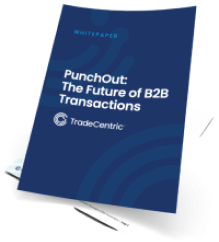Table of Contents
cXML defined is a protocol format that exchanges data between an eCommerce system, eProcurement system, and other business software to streamline B2B sales processes. The protocol defines how organizations transmit information and the steps involved in communicating documents and verifying that they have been received. The format defines the structure and content of cXML documents via a set of XML Document Type Definitions (DTD).
XML is a widely used markup format, and XML DTDs define the rules that encode a specific type of document. If you’re familiar with HTML, you’ll recognize the format of XML documents, which use tags such as to enclose and describe the data. cXML DTDs cover most of the information that businesses want to exchange during procurement, as well as documents that support synchronization and integration throughout the TradeCentric process.
This protocol was first developed by Ariba in 1999 with input from numerous organizations. Ariba created it to provide an easy-to-use protocol for integrating eProcurement and eCommerce software, powering TradeCentric catalogs, and automated procurement workflows.
What is cXML based on?
cXML is based on the XML extensible markup language, which is used to store, transmit, and reconstruct data. These documents are composed of tag/value pairs that will be familiar to anyone who knows HTML. For example, the tag for encoding the name of an order’s recipient looks like this:
- First Name: Sally
- Last Name: Smith
- Unique Name: DKEf6d8
- User Email: [email protected]
- User: DKEf6d8
- Business Unit: 13843
- Email: [email protected]
- Name: DKEf6d8
- Unique: DKEf6d8
- Buyercookie: 7555371f46f7a5d057ac3567a2df12c2
- Postform: https://acme_buyer.coupahost.com/punchout/checkout?id=1
cXML describes a series of standard documents in this format that eProcurement and eCommerce developers can implement.
In addition to the specifications, cXML documents also describe a pair of protocols for communicating data between platforms: a Request-Response model and a one-way model. The Request-Response model is used more widely and provides a protocol for two-way communication using standard HTTP(S) requests.
cXML vs. other document types
cXML vs EDI
EDI (Electronic Data Interchange) is an older protocol first developed in the late 1960s. It provides a set of standards for digitally exchanging information, but it is much broader in scope and although it supports the transfer of catalog data, it does not support eCommerce-integrated TradeCentric catalogs. While cXML is tightly focused on procurement documents and TradeCentric catalogs, EDI defines standards for communicating a huge variety of business documents.
cXML is less complex than EDI and less expensive to implement. XML is a widely supported markup language—most popular programming languages and frameworks support XML natively or via a library. Additionally, many eProcurement and ERP platforms support cXML out-of-the-box, which is not the case for EDI.
Because cXML is based on XML, it is extensible: organizations can adapt it to better meet their needs. EDI is much more complex and it is not designed to be extensible by the user.
cXML vs OCI
OCI (Open Catalog Interface) is SAP’s alternative to Ariba’s cXML. It is a standardized interface that can integrate a seller’s catalog into a buyer’s eProcurement or enterprise resource planning application, allowing buyers to build orders and have them transferred as a purchase order into their procurement platform.
In contrast, OCI is entirely focused on the TradeCentric process, and it does not provide additional B2B procurement automation functionality such as invoice and advanced shipping order communication.
How is cXML used in PunchOut catalogs?
For a PunchOut catalog experience to quickly and accurately transfer data back and forth, it uses commerce extensible markup language or commerce XML (cXML). Primarily used to exchange shopping cart data and electronic documents, such as purchase orders, ship notice documents, and invoices.
PunchOut catalogs allow a buyer to select a supplier from within their eProcurement solution. They are forwarded to the supplier’s eCommerce store and authenticated. Once they have selected the products they need, they transfer the order details to their eProcurement solution, where a requisition order is created.
In many eProcurement solutions and eCommerce applications, cXML is the data format that makes this level of integration and automation possible, streamlining the modern online procurement process and saving time and costs for the business.
Need a PunchOut Catalog Solution?
What does integration using cXML look like?
Behind the scenes, a typical cXML PunchOut session looks like this:
- Buyer authentication. When the buyer selects a vendor, the eProcurement platform sends a PunchOut Setup Request to the seller’s eCommerce store. The request is accompanied by a cXML document that includes details such as the buyer’s name, contact information, and unique identifiers for authentication that vary by procurement system and by unique buyer requirements.
- Store or product page navigation. The eCommerce store responds with a PunchOut Setup Response, again accompanied by a cXML document that includes, among other data, the redirect URL of the store. The eProcurement platform redirects the user to that URL, which is generally the homepage or a page defined for the buyer organization. In the case of Level 2 PunchOut Catalogs, the user is sent directly to a product page.
- Order transfer. After products are selected, the buyer hits a “transfer order” button in the eCommerce store, which sends a PunchOut Order Message (POOM) to the eProcurement platform. The accompanying cXML encodes details such as product descriptions and ID numbers, unit prices, the unit of measure, UNSPSC codes and the currency. To some extent, these details can also vary by eProcurement solution.
From the buyer’s perspective, this process is entirely automated and intuitive. They choose a supplier, put items in their cart, and “check out.” The eProcurement platform and the eCommerce store invisibly handle authentication, data exchange, and requisition order creation within the buyers originating eProcurement or ERP system.
As fast and seamless as cXML data transfer process is, it can be further expanded with purchase order automation, which sends a purchase order to the supplier’s eCommerce store or order management system when an eProcurement requisition order is approved. Other documents include order confirmations, shipping notice documents and invoices.
Why use PunchOut and cXML?
For companies that rely on eProcurement for business transactions, PunchOut creates a superior B2B eCommerce experience. A recent study from Digital Commerce 360 revealed that eProcurement is the fastest growing B2B sales channel and that eProcurement users want to integrate as many suppliers as possible for PunchOut and other procurement automation functionality.
PunchOut and procurement automation helps buyers to:
- Eliminate error-prone manual data entry.
- Access approved suppliers in a single interface with a real-time product, availability, and pre-negotiated pricing.
- Improve procurement productivity and accelerate the purchase cycle.
- Centralize procurement data to increase visibility and control spending.
Suppliers also realize considerable benefits from PunchOut:
- Win new business from eProcurement users and strengthen existing sales relationships.
- Ensure buyers have access to up-to-date, personalized catalogs.
- Reduce procurement costs by moving buyers to their eCommerce platform instead of more expensive, labor-intensive channels.
What are the benefits of PunchOut catalogs and cXML?
The benefits of PunchOut solutions are clear, but both buyers and suppliers can face implementation challenges while onboarding this technology. cXML is just one of the data formats supported by eProcurement and ERP platforms; there is also the older EDI protocol and modern alternatives such as the Open Catalog Interface (OCI) and Oracle XML, and custom formats and protocols.
TradeCentric protocol support
The TradeCentric Integration Platform as a Service (iPaas) supports cXML, EDI, OCI, and numerous other protocols and formats. We seamlessly translate between multiple formats, empowering B2B buyers and suppliers to integrate any eCommerce store with any eProcurement or ERP platform for TradeCentric catalogs and purchase order automation. This ensures a streamlined process for both buyers and suppliers without the added expenses or complexities of inaccurate system mapping.
WHITEPAPER
Connect eCommerce systems with eProcurement solutions to enable seamless purchasing
Download




